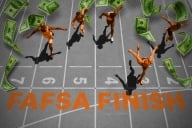You have /5 articles left.
Sign up for a free account or log in.
About 432,000 borrowers have submitted employment forms demonstrating they would qualify for the federal Public Service Loan Forgiveness program beginning in October 2017, the U.S. Department of Education said Monday.
Borrowers who qualify for the program can have their remaining student loan balance forgiven after 10 years of regular repayment while working in the government or nonprofit sectors. Although borrowers won’t be eligible to have federal loans forgiven until next year, the department’s Office of Federal Student Aid released those preliminary numbers Monday along with other updates to student loan data on its website.
The data released by the department Monday also showed steady growth in enrollment for income-driven repayment plans. As of June, more than 5.3 million direct loan borrowers had enrolled in one of those plans, up 36 percent from the previous year.
“Today’s report demonstrates measurable progress in our efforts to help borrowers successfully manage repayment,” U.S. Secretary of Education John B. King Jr. said in a statement. “We want to ensure that those Americans who have devoted a decade of their careers to public service are not burdened by debt while making invaluable professional contributions to their communities.”
Congress passed the loan forgiveness program in 2007 and the department started making the annual employment certification forms available in 2012 to help borrowers track their eligibility. The Department of Education has received almost a million certification forms from borrowers -- some borrowers have submitted multiple forms because of job changes. About two-thirds of those have been approved.
Rachel Fishman, a policy analyst at New America, said she expected some confusion on who will qualify for the loan forgiveness program to persist as the deadline approaches next year. But the large number of applicants may reflect outreach efforts for the program by the department and loan servicers and could be understating the eventual interest in the program, she said.
“I think it’s anyone’s guess what the actual numbers will look like,” she said.
Fishman said she had actually submitted two employment certification forms herself and had one rejected, although it was for a qualified employer. She is in the process of resubmitting that form.
A report from the Consumer Financial Protection Bureau last week found that many borrowers complained of obstacles in applying to income-driven repayment plans. The report called on loan servicers to do a better job providing guidance to borrowers on how to take advantage of those programs. Fishman said that report could be indicative of the challenges to applying for the Public Service Loan Forgiveness program.
The numbers released by the department Monday also showed new defaults on direct loans had declined for the third straight quarter.
Robert Kelchen, an assistant professor of higher education at Seton Hall University whose focus includes student aid, said as more borrowers take advantage of affordable payment programs, there should be a drop in the number of defaults on student loan defaults. He said it is still too early to attribute a decline to income-driven repayment programs but that next year’s default data could begin to reflect the impact of those programs.








